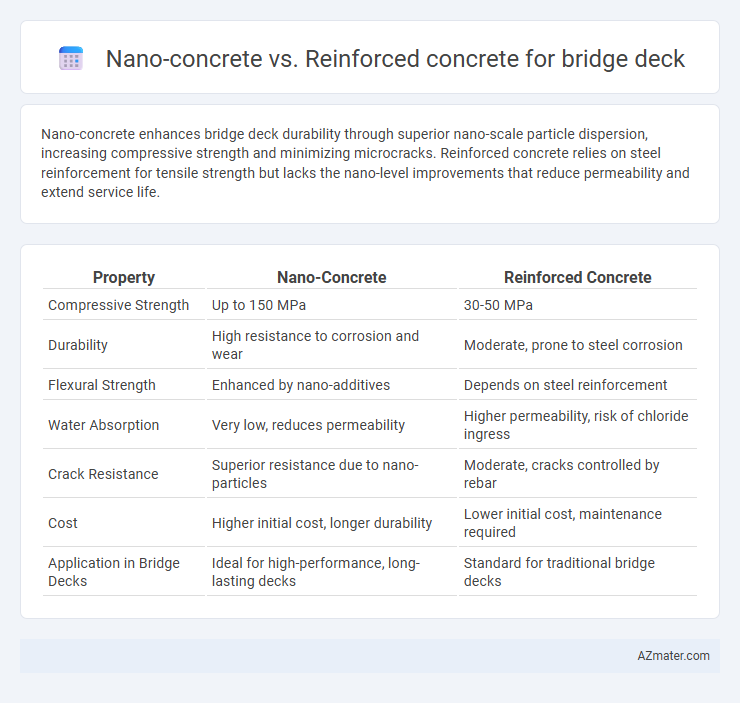Nano-concrete enhances bridge deck durability through superior nano-scale particle dispersion, increasing compressive strength and minimizing microcracks. Reinforced concrete relies on steel reinforcement for tensile strength but lacks the nano-level improvements that reduce permeability and extend service life.
Table of Comparison
| Property | Nano-Concrete | Reinforced Concrete |
|---|---|---|
| Compressive Strength | Up to 150 MPa | 30-50 MPa |
| Durability | High resistance to corrosion and wear | Moderate, prone to steel corrosion |
| Flexural Strength | Enhanced by nano-additives | Depends on steel reinforcement |
| Water Absorption | Very low, reduces permeability | Higher permeability, risk of chloride ingress |
| Crack Resistance | Superior resistance due to nano-particles | Moderate, cracks controlled by rebar |
| Cost | Higher initial cost, longer durability | Lower initial cost, maintenance required |
| Application in Bridge Decks | Ideal for high-performance, long-lasting decks | Standard for traditional bridge decks |
Introduction to Nano-Concrete and Reinforced Concrete
Nano-concrete integrates nanoparticles like silica or titanium dioxide into traditional concrete, enhancing durability, strength, and crack resistance for bridge decks. Reinforced concrete combines concrete with steel rebar to improve tensile strength and structural integrity under dynamic loads. Both materials address key performance criteria, with nano-concrete offering advanced microstructural improvements and reinforced concrete providing proven load-bearing capacity.
Material Composition and Characteristics
Nano-concrete for bridge decks incorporates nanoparticles like nanosilica or carbon nanotubes, enhancing density, strength, and durability by refining the microstructure and reducing porosity. Reinforced concrete combines conventional cement, aggregates, and steel reinforcement bars that provide tensile strength and load-bearing capacity but may suffer from corrosion over time. Nano-concrete's improved mechanical properties and resistance to cracking make it a superior alternative in extending bridge deck lifespan and reducing maintenance.
Strength and Durability Comparison
Nano-concrete exhibits significantly enhanced compressive strength and fracture toughness compared to traditional reinforced concrete, due to the uniform dispersion of nanoparticles that refine the microstructure and reduce porosity. The durability of nano-concrete in bridge decks surpasses reinforced concrete by providing superior resistance to chloride ion penetration, freeze-thaw cycles, and sulfate attacks, thereby extending service life and reducing maintenance costs. Reinforced concrete remains susceptible to steel corrosion and micro-cracking, which compromises long-term structural integrity under aggressive environmental conditions.
Performance in Harsh Environmental Conditions
Nano-concrete exhibits superior durability and resistance to harsh environmental conditions compared to reinforced concrete due to its enhanced microstructure and reduced porosity, which limits water ingress and chloride ion penetration. Reinforced concrete is prone to corrosion of steel reinforcements when exposed to de-icing salts, freeze-thaw cycles, and marine environments, leading to structural degradation over time. The incorporation of nano-materials in nano-concrete significantly improves mechanical strength, freeze-thaw resistance, and impermeability, making it a preferred choice for bridge decks in aggressive climates.
Flexural and Compressive Strength Differences
Nano-concrete exhibits significantly higher compressive strength compared to traditional reinforced concrete, often exceeding 20-30% improvement due to the enhanced particle packing and reduced micro-cracking from nano-sized additives. Flexural strength in nano-concrete also surpasses that of reinforced concrete, as the nanoparticles improve the interfacial transition zone between cement paste and aggregates, resulting in better load transfer and crack resistance. These advancements in nano-concrete contribute to longer-lasting bridge decks with increased durability and reduced maintenance needs.
Construction Methods and Adaptability
Nano-concrete for bridge decks utilizes nanomaterials such as nanosilica and carbon nanotubes to enhance microstructure and mechanical properties, enabling faster curing times and improved durability compared to traditional reinforced concrete. Its construction method involves precise mixing techniques and specialized equipment to ensure uniform dispersion of nanomaterials, allowing for thinner, lighter bridge decks with higher load-bearing capacity. Reinforced concrete relies on conventional casting and steel reinforcement placement, offering widespread adaptability and ease of use in diverse construction environments but may require longer curing periods and thicker sections to achieve comparable strength.
Lifecycle Cost and Maintenance
Nano-concrete offers superior durability and reduced permeability compared to traditional reinforced concrete, leading to significantly lower maintenance costs over the bridge deck's lifecycle. Reinforced concrete typically experiences more frequent repairs due to corrosion of steel reinforcement, increasing lifecycle expenses. The enhanced mechanical properties and self-healing capabilities of nano-concrete extend service life, making it a cost-effective choice for bridge deck applications.
Sustainability and Environmental Impact
Nano-concrete enhances bridge deck sustainability through its reduced material consumption and longer lifespan, significantly lowering carbon emissions compared to traditional reinforced concrete. Reinforced concrete, while durable, often requires higher energy-intensive cement production contributing to greater environmental impact. The integration of nanomaterials in nano-concrete improves durability and crack resistance, minimizing maintenance needs and resource usage over the bridge's lifecycle.
Case Studies: Bridge Deck Applications
Case studies on bridge deck applications reveal that nano-concrete significantly enhances durability and crack resistance compared to traditional reinforced concrete. In projects like the Guangzhou Nanpu Bridge, nano-concrete demonstrated improved mechanical properties and reduced permeability, leading to extended service life. Reinforced concrete remains widely used due to its established design protocols, but nano-concrete offers superior performance in aggressive environments, reducing maintenance costs and increasing structural resilience.
Future Trends and Innovations in Concrete Technology
Nano-concrete integrates nanoparticles like silica and titanium dioxide to enhance strength, durability, and self-healing properties, offering transformative potential for bridge decks compared to traditional reinforced concrete. Advances in nanomaterials optimize microstructure and reduce permeability, resulting in longer lifespan and lower maintenance costs. Future trends include smart nano-concretes with embedded sensors for real-time structural health monitoring and adaptive response to environmental stressors.

Infographic: Nano-concrete vs Reinforced concrete for Bridge deck
 azmater.com
azmater.com